What Type Of Particles/sediment Makeup Limestone? How Is Calcium Carbonate Produced By Coral Reefs?
| Sedimentary rock | |
 Limestone outcrop in the Torcal de Antequera nature reserve of Málaga, Espana | |
| Composition | |
|---|---|
| Calcium carbonate: inorganic crystalline calcite or organic calcareous fabric |
Limestone is a common type of carbonate sedimentary rock which is the principal source of the material lime. Information technology is composed mostly of the minerals calcite and aragonite, which are dissimilar crystal forms of calcium carbonate (CaCOthree ). Limestone forms when these minerals precipitate out of water containing dissolved calcium. This tin can take place through both biological and nonbiological processes, though biological processes, such equally the accumulation of corals and shells in the sea, have likely been more of import for the concluding 540 1000000 years.[one] [2] Limestone often contains fossils, and these provide scientists with information on ancient environments and on the evolution of life.[3]
About xx% to 25% of sedimentary stone is carbonate rock, and most of this is limestone.[iv] [three] The remaining carbonate rock is mostly dolomite, a closely related rock, which contains a high per centum of the mineral dolomite, CaMg(COiii)ii . Magnesian limestone is an obsolete and poorly-defined term used variously for dolomite, for limestone containing significant dolomite (dolomitic limestone), or for any other limestone containing a significant percent of magnesium.[5] Most limestone was formed in shallow marine environments, such as continental shelves or platforms, though smaller amounts were formed in many other environments. Much dolomite is secondary dolomite, formed by chemical amending of limestone.[vi] [7] Limestone is exposed over large regions of the Earth's surface, and because limestone is slightly soluble in rainwater, these exposures oftentimes are eroded to become karst landscapes. Most cavern systems are found in limestone bedrock.
Limestone has numerous uses: as a building fabric, an essential component of concrete (Portland cement), as aggregate for the base of roads, equally white pigment or filler in products such every bit toothpaste or paints, equally a chemical feedstock for the production of lime, as a soil conditioner, and every bit a pop decorative addition to rock gardens. Limestone formations contain about thirty% of the world's petroleum reservoirs.[3]
Description [edit]

Limestone is composed mostly of the minerals calcite and aragonite, which are different crystal forms of calcium carbonate (CaCO3 ). Dolomite, CaMg(COthree)ii , is an uncommon mineral in limestone, and siderite or other carbonate minerals are rare. However, the calcite in limestone oft contains a few percent of magnesium. Calcite in limestone is divided into low-magnesium and high-magnesium calcite, with the dividing line placed at a composition of four% magnesium. High-magnesium calcite retains the calcite mineral construction, which is singled-out from dolomite. Aragonite does not usually contain pregnant magnesium.[eight] Most limestone is otherwise chemically fairly pure, with clastic sediments (mainly fine-grained quartz and dirt minerals) making up less than v%[9] to 10%[ten] of the composition. Organic affair typically makes up around 0.2% of a limestone and rarely exceeds 1%.[11]
Limestone often contains variable amounts of silica in the form of chert or siliceous skeletal fragments (such as sponge spicules, diatoms, or radiolarians).[12] Fossils are also common in limestone.[3]
Limestone is commonly white to gray in color. Limestone that is unusually rich in organic matter can be well-nigh black in color, while traces of iron or manganese tin can give limestone an off-white to yellow to cherry-red colour. The density of limestone depends on its porosity, which varies from 0.1% for the densest limestone to 40% for chalk. The density correspondingly ranges from 1.v to 2.vii g/cm3. Although relatively soft, with a Mohs hardness of 2 to iv, dense limestone tin can take a crushing forcefulness of upwardly to 180 MPa.[13] For comparison, concrete typically has a burdensome force of virtually 40 MPa.[fourteen]
Although limestones show trivial variability in mineral composition, they prove great diversity in texture.[15] However, well-nigh limestone consists of sand-sized grains in a carbonate mud matrix. Considering limestones are often of biological origin and are usually composed of sediment that is deposited shut to where it formed, classification of limestone is usually based on its grain type and mud content.[nine]
Grains [edit]


Ooids in limestone of the Carmel Formation (Middle Jurassic) of southwestern Utah.
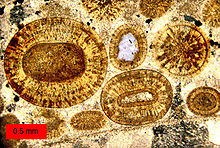
Thin-department view of a Middle Jurassic limestone in southern Utah, U.S. The round grains are ooids; the largest is i.2 mm (0.05 in) in bore. This limestone is an oosparite.
Nigh grains in limestone are skeletal fragments of marine organisms such as coral or foraminifera.[16] These organisms secrete structures made of aragonite or calcite, and get out these structures behind when they die. Other carbonate grains composing limestones are ooids, peloids, and limeclasts (intraclasts and extraclasts).[17]
Skeletal grains accept a composition reflecting the organisms that produced them and the environment in which they were produced.[xviii] Low-magnesium calcite skeletal grains are typical of clear brachiopods, planktonic (costless-floating) foraminifera, and coccoliths. High-magnesium calcite skeletal grains are typical of benthic (bottom-domicile) foraminifera, echinoderms, and coralline algae. Aragonite skeletal grains are typical of molluscs, calcareous green algae, stromatoporoids, corals, and tube worms. The skeletal grains also reflect specific geological periods and environments. For example, coral grains are more than common in high-energy environments (characterized past potent currents and turbulence) while bryozoan grains are more common in low-energy environments (characterized past quiet water).[19]
Ooids (sometimes called ooliths) are sand-sized grains (less than 2mm in diameter) consisting of one or more layers of calcite or aragonite effectually a cardinal quartz grain or carbonate mineral fragment. These probable course by straight precipitation of calcium carbonate onto the ooid. Pisoliths are like to ooids, but they are larger than 2mm in diameter and tend to be more irregular in shape. Limestone composed mostly of ooids is called an oolite or sometimes an oolitic limestone. Ooids class in high-energy environments, such as the Bahama platform, and oolites typically show crossbedding and other features associated with degradation in potent currents.[20] [21]
Oncoliths resemble ooids but bear witness a radial rather than layered internal structure, indicating that they were formed by algae in a normal marine environment.[20]
Peloids are structureless grains of microcrystalline carbonate probable produced past a variety of processes.[22] Many are thought to be fecal pellets produced past marine organisms. Others may be produced by endolithic (tedious) algae[23] or other microorganisms[24] or through breakdown of mollusc shells.[25] They are difficult to meet in a limestone sample except in thin section and are less common in aboriginal limestones, possibly because compaction of carbonate sediments disrupts them.[23]
Limeclasts are fragments of existing limestone or partially lithified carbonate sediments. Intraclasts are limeclasts that originate close to where they are deposited in limestone, while extraclasts come from outside the depositional expanse. Intraclasts include grapestone, which is clusters of peloids cemented together past organic material or mineral cement. Extraclasts are uncommon, are usually accompanied by other clastic sediments, and indicate degradation in a tectonically agile area or as office of a turbidity current.[26]
Mud [edit]
The grains of most limestones are embedded in a matrix of carbonate mud. This is typically the largest fraction of an ancient carbonate rock.[23] Mud consisting of individual crystals less than 5 microns in length is described as micrite.[27] In fresh carbonate mud, micrite is mostly small aragonite needles, which may precipitate directly from seawater,[28] be secreted by algae,[29] or be produced by abrasion of carbonate grains in a high-energy environment.[30] This is converted to calcite within a few million years of deposition. Further recrystallization of micrite produces microspar, with grains from 5 to 15 microns in diameter.[28]
Limestone often contains larger crystals of calcite, ranging in size from 0.02 to 0.1 mm, that are described equally sparry calcite or sparite. Sparite is distinguished from micrite by a grain size of over 20 microns and considering sparite stands out under a mitt lens or in sparse section equally white or transparent crystals. Sparite is distinguished from carbonate grains by its lack of internal structure and its feature crystal shapes. [31]
Geologists are conscientious to distinguish between sparite deposited as cement and sparite formed by recrystallization of micrite or carbonate grains. Sparite cement was likely deposited in pore space between grains, suggesting a loftier-energy depositional environment that removed carbonate mud. Recrystallized sparite is non diagnostic of depositional environs.[31]
Other characteristics [edit]

Limestone outcrops are recognized in the field by their softness (calcite and aragonite both have a Mohs hardness of less than 4, well below mutual silicate minerals) and considering limestone bubbles vigorously when a driblet of dilute hydrochloric acid is dropped on it. Dolomite is also soft just reacts only feebly with dilute hydrochloric acid, and information technology usually weathers to a characteristic slow yellow-brown color due to the presence of ferrous iron. This is released and oxidized as the dolomite weathers.[9] Impurities (such equally clay, sand, organic remains, iron oxide, and other materials) will cause limestones to exhibit unlike colors, especially with weathered surfaces.
The makeup of a carbonate rock outcrop can be estimated in the field by etching the surface with dilute hydrochloric acid. This etches abroad the calcite and aragonite, leaving behind whatever silica or dolomite grains. The latter can exist identified by their rhombohedral shape.[nine]
Crystals of calcite, quartz, dolomite or barite may line minor cavities (vugs) in the rock. Vugs are a form of secondary porosity, formed in existing limestone by a modify in environment that increases the solubility of calcite.[32]
Dumbo, massive limestone is sometimes described every bit "marble". For case, the famous Portoro "marble" of Italy is actually a dense black limestone.[33] True marble is produced past recrystallization of limestone during regional metamorphism that accompanies the mountain building procedure (orogeny). Information technology is distinguished from dense limestone by its coarse crystalline texture and the formation of distinctive minerals from the silica and clay present in the original limestone.[34]
Classification [edit]
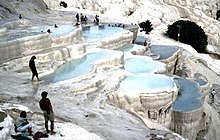
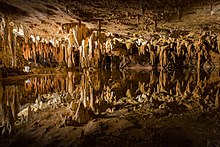
2 major nomenclature schemes, the Folk and Dunham, are used for identifying the types of carbonate rocks collectively known as limestone.
Folk nomenclature [edit]
Robert L. Folk developed a classification system that places master accent on the detailed composition of grains and interstitial fabric in carbonate rocks.[35] Based on composition, in that location are iii master components: allochems (grains), matrix (mostly micrite), and cement (sparite). The Folk organization uses two-role names; the start refers to the grains and the second to the cement. For case, a limestone consisting mainly of ooids, with a crystalline matrix, would exist termed an oosparite. It is helpful to have a petrographic microscope when using the Folk scheme, because it is easier to determine the components nowadays in each sample.[36]
Dunham classification [edit]
Robert J. Dunham published his organisation for limestone in 1962. It focuses on the depositional fabric of carbonate rocks. Dunham divides the rocks into four primary groups based on relative proportions of coarser clastic particles, based on criteria such as whether the grains were originally in mutual contact, and therefore self-supporting, or whether the rock is characterized by the presence of frame builders and algal mats. Unlike the Folk scheme, Dunham deals with the original porosity of the rock. The Dunham scheme is more useful for hand samples because information technology is based on texture, not the grains in the sample.[37]
A revised nomenclature was proposed by Wright (1992). It adds some diagenetic patterns to the classification scheme.[38]
Other descriptive terms [edit]
Travertine is a term applied to calcium carbonate deposits formed in freshwater environments, particularly hot springs. Such deposits are typically massive, dumbo, and banded. When the deposits are highly porous, and then that they have a spongelike texture, they are typically described equally tufa. Secondary calcite deposited by supersaturated meteoric waters (groundwater) in caves is besides sometimes described as travertine. This produces speleothems, such every bit stalagmites and stalactites.[39]
Coquina is a poorly consolidated limestone composed of abraded pieces of coral, shells, or other fossil droppings. When better consolidated, it is described every bit coquinite.[40]
Chalk is a soft, earthy, fine-textured limestone composed of the tests of planktonic microorganisms such as foraminifera, while marl is an bawdy mixture of carbonates and silicate sediments.[40]
Formation [edit]
Limestone forms when calcite or aragonite precipitate out of water containing dissolved calcium, which can take identify through both biological and nonbiological processes.[41] The solubility of calcium carbonate (CaCOthree ) is controlled largely by the amount of dissolved carbon dioxide (CO2 ) in the water. This is summarized in the reaction:
-
- CaCO3 + H2O + CO2 → Ca2+ + 2HCO − 3
Increases in temperature or decreases in pressure level tend to reduce the amount of dissolved COii and precipitate CaCO3 . Reduction in salinity also reduces the solubility of CaCO3 , by several orders of magnitude for fresh h2o versus seawater. [42]
Near-surface water of the earth's oceans are oversaturated with CaCOthree by a factor of more than 6.[43] The failure of CaCO3 to apace precipitate out of these waters is likely due to interference past dissolved magnesium ions with nucleation of calcite crystals, the necessary first stride in atmospheric precipitation. Precipitation of aragonite may be suppressed by the presence of naturally occurring organic phosphates in the water. Although ooids probable form through purely inorganic processes, the bulk of CaCO3 precipitation in the oceans is the result of biological action.[44] Much of this takes place on carbonate platforms.
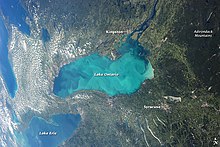
An aerial view of a whiting event atmospheric precipitation cloud in Lake Ontario.
The origin of carbonate mud,[xxx] and the processes by which it is converted to micrite,[45] keep to exist a subject of enquiry. Modern carbonate mud is composed more often than not of aragonite needles effectually five microns in length. Needles of this shape and limerick are produced by calcareous algae such as Penicillus, making this a plausible source of mud.[46] Another possibility is direct atmospheric precipitation from the water. A phenomenon known as whitings occurs in shallow waters, in which white streaks containing dispersed micrite appear on the surface of the water. It is uncertain whether this is freshly precipitated aragonite or simply material stirred up from the bottom, but there is some evidence that whitings are caused by biological precipitation of aragonite as part of a flower of cyanobacteria or microalgae.[47] However, stable isotope ratios in modern carbonate mud appear to be inconsistent with either of these mechanisms, and abrasion of carbonate grains in high-free energy environments has been put forward every bit a third possibility.[xxx]
Formation of limestone has likely been dominated by biological processes throughout the Phanerozoic, the last 540 one thousand thousand years of the Globe'southward history. Limestone may accept been deposited past microorganisms in the Precambrian, prior to 540 million years ago, but inorganic processes were probably more than important and likely took place in an ocean more than highly oversaturated in calcium carbonate than the modern ocean.[48]
Diagenesis [edit]
Diagenesis is the process in which sediments are compacted and turned into solid rock. During diagenesis of carbonate sediments, significant chemic and textural changes accept place. For example, aragonite is converted to low-magnesium calcite. Diagenesis is the likely origin of pisoliths, concentrically layered particles ranging from 1 to ten millimeters (0.039 to 0.394 in) in bore establish in some limestones. Pisoliths superficially resemble ooids merely have no nucleus of foreign matter, fit together tightly, and bear witness other signs that they formed afterward the original deposition of the sediments.[49]

Akcakoca chert nodules within soft limestone

Silicification occurs early on in diagenesis, at low pH and temperature, and contributes to fossil preservation. Silicification takes place through the reaction:
-
- CaCOiii + H2O + CO2 + HivSiOiv → SiO2 + Ca2+ + 2HCO − 3 + 2 H2O
Fossils are often preserved in exquisite particular every bit chert.[fifty]
Cementing takes place speedily in carbonate sediments, typically inside less than a million years of deposition. Some cementing occurs while the sediments are still under water, forming hardgrounds. Cementing accelerates after the retreat of the bounding main from the depositional environs, equally rainwater infiltrates the sediment beds, often within just a few chiliad years. Equally rainwater mixes with groundwater, aragonite and high-magnesium calcite are converted to low-calcium calcite. Cementing of thick carbonate deposits by rainwater may commence even before the retreat of the ocean, as rainwater can infiltrate over 100 kilometers (60 mi) into sediments beneath the continental shelf.[51]
As carbonate sediments are increasingly deeply cached under younger sediments, chemical and mechanical compaction of the sediments increases. Chemical compaction takes identify by pressure solution of the sediments. This procedure dissolves minerals from points of contact between grains and redeposits it in pore space, reducing the porosity of the limestone from an initial loftier value of 40% to 80% to less than 10%.[52] Pressure solution produces distinctive styolites, irregular surfaces within the limestone at which silica-rich sediments accumulate. These may reflect dissolution and loss of a considerable fraction of the limestone bed. At depths greater than one kilometer (0.62 mi), burial cementation completes the lithification process. Burial cementation does not produce styolites.[53]
When overlying beds are eroded, bringing limestone closer to the surface, the last stage of diagenesis takes place. This produces secondary porosity as some of the cement is dissolved past rainwater infiltrating the beds. This may include the formation of vugs, which are crystal-lined cavities within the limestone.[53]
Diagenesis may include conversion of limestone to dolomite past magnesium-rich fluids. There is considerable testify of replacement of limestone by dolomite, including sharp replacement boundaries that cutting across bedding.[54] The process of dolomitization remains an area of active research,[55] but possible mechanisms include exposure to concentrated brines in hot environments (evaporative reflux) or exposure to diluted seawater in delta or estuary environments (Dorag dolomitization).[56] However, Dorag dolomitization has fallen into disfavor equally a machinery for dolomitization,[57] with one 2004 review paper describing it bluntly as "a myth".[55] Ordinary seawater is capable of converting calcite to dolomite, if the seawater is regularly flushed through the rock, as by the ebb and flow of tides (tidal pumping).[54] Once dolomitization begins, it proceeds rapidly, then that there is very trivial carbonate rock containing mixed calcite and dolomite. Carbonate stone tends to exist either nearly all calcite/aragonite or almost all dolomite.[56]
Occurrence [edit]
About 20% to 25% of sedimentary rock is carbonate rock,[3] and most of this is limestone.[17] [3] Limestone is found in sedimentary sequences as sometime as ii.seven billion years.[58] Nevertheless, the compositions of carbonate rocks testify an uneven distribution in time in the geologic record. About 95% of modern carbonates are equanimous of high-magnesium calcite and aragonite.[59] The aragonite needles in carbonate mud are converted to depression-magnesium calcite within a few million years, as this is the most stable class of calcium carbonate.[28] Ancient carbonate formations of the Precambrian and Paleozoic contain arable dolomite, but limestone dominates the carbonate beds of the Mesozoic and Cenozoic. Modern dolomite is quite rare. There is prove that, while the modernistic bounding main favors precipitation of aragonite, the oceans of the Paleozoic and middle to tardily Cenozoic favored precipitation of calcite. This may indicate a lower Mg/Ca ratio in the ocean h2o of those times.[threescore] This magnesium depletion may exist a consequence of more rapid body of water floor spreading, which removes magnesium from ocean water. The modern ocean and the ocean of the Mesozoic have been described equally "aragonite seas".[61]
Most limestone was formed in shallow marine environments, such every bit continental shelves or platforms. Such environments form only about 5% of the ocean basins, but limestone is rarely preserved in continental gradient and deep body of water environments. The best environments for degradation are warm waters, which have both a high organic productivity and increased saturation of calcium carbonate due to lower concentrations of dissolved carbon dioxide. Modern limestone deposits are almost always in areas with very little silica-rich sedimentation, reflected in the relative purity of most limestones. Reef organisms are destroyed by muddy, brackish river water, and carbonate grains are footing down by much harder silicate grains.[62] Different clastic sedimentary stone, limestone is produced almost entirely from sediments originating at or most the place of degradation.[63]
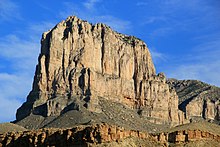
Limestone formations tend to evidence abrupt changes in thickness. Large moundlike features in a limestone formation are interpreted equally aboriginal reefs, which when they announced in the geologic record are called bioherms. Many are rich in fossils, merely most lack any connected organic framework like that seen in modern reefs. The fossil remains are present equally separate fragments embedded in aplenty mud matrix. Much of the sedimentation shows indications of occurring in the intertidal or supratidal zones, suggesting sediments quickly fill available adaptation infinite in the shelf or platform.[64] Deposition is also favored on the seaward margin of shelves and platforms, where there is upwelling deep body of water water rich in nutrients that increase organic productivity. Reefs are common hither, but when defective, ooid shoals are found instead. Effectively sediments are deposited shut to shore.[65]
The lack of deep bounding main limestones is due in part to rapid subduction of oceanic chaff, merely is more a result of dissolution of calcium carbonate at depth. The solubility of calcium carbonate increases with force per unit area and fifty-fifty more than with college concentrations of carbon dioxide, which is produced past decaying organic matter settling into the deep sea that is not removed by photosynthesis in the dark depths. As a result, there is a fairly sharp transition from water saturated with calcium carbonate to h2o unsaturated with calcium carbonate, the lysocline, which occurs at the calcite compensation depth of 4,000 to 7,000 meters (13,000 to 23,000 ft). Beneath this depth, foraminifera tests and other skeletal particles rapidly dissolve, and the sediments of the ocean floor abruptly transition from carbonate ooze rich in foraminifera and coccolith remains (Globigerina ooze) to silicic mud defective carbonates.[66]

In rare cases, turbidites or other silica-rich sediments bury and preserve benthic (deep ocean) carbonate deposits. Ancient benthic limestones are microcrystalline and are identified by their tectonic setting. Fossils typically are foraminifera and coccoliths. No pre-Jurassic benthic limestones are known, probably because carbonate-shelled plankton had not yet evolved.[67]
Limestones also form in freshwater environments.[68] These limestones are not unlike marine limestone, simply accept a lower variety of organisms and a greater fraction of silica and clay minerals characteristic of marls. The Greenish River Germination is an example of a prominent freshwater sedimentary formation containing numerous limestone beds.[69] Freshwater limestone is typically micritic. Fossils of charophyte (stonewort), a grade of freshwater greenish algae, are characteristic of these environments, where the charophytes produce and trap carbonates.[70]
Limestones may also form in evaporite depositional environments.[71] [72] Calcite is one of the first minerals to precipitate in marine evaporites.[73]
Limestone and living organisms [edit]
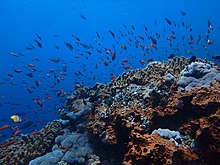
About limestone is formed by the activities of living organisms near reefs, but the organisms responsible for reef formation have changed over geologic time. For example, stromatolites are mound-shaped structures in ancient limestones, interpreted as colonies of blue-green alga that accumulated carbonate sediments, simply stromatolites are rare in younger limestones.[74] Organisms precipitate limestone both straight as office of their skeletons, and indirectly by removing carbon dioxide from the water past photosynthesis and thereby decreasing the solubility of calcium carbonate.[70]
Limestone shows the same range of sedimentary structures found in other sedimentary rocks. However, finer structures, such every bit lamination, are frequently destroyed by the burrowing activities of organisms (bioturbation). Fine lamination is feature of limestone formed in playa lakes, which lack the burrowing organisms.[75] Limestones also show distinctive features such as geopetal structures, which course when curved shells settle to the lesser with the concave face downwards. This traps a void space that can after be filled past sparite. Geologists use geopetal structures to determine which management was up at the time of deposition, which is non e'er obvious with highly deformed limestone formations.[76]
The cyanobacterium Hyella balani tin bore through limestone; as can the greenish alga Eugamantia sacculata and the fungus Ostracolaba implexa.[77]
Micritic mud mounds [edit]
Micricitic mud mounds are subcircular domes of micritic calcite that lacks internal construction. Mod examples are up to several hundred meters thick and a kilometer across, and have steep slopes (with slope angles of around l degrees). They may be composed of peloids swept together by currents and stabilized past Thallasia grass or mangroves. Bryozoa may also contribute to mound formation by helping to trap sediments.[78]
Mud mounds are found throughout the geologic tape, and prior to the early on Ordovician, they were the dominant reef type in both deep and shallow h2o. These mud mounds probable are microbial in origin. Following the advent of frame-edifice reef organisms, mud mounds were restricted mainly to deeper water.[79]
Organic reefs [edit]
Organic reefs form at depression latitudes in shallow water, not more than a few meters deep. They are complex, diverse structures establish throughout the fossil record. The frame-building organisms responsible for organic reef formation are characteristic of different geologic time periods: Archaeocyathids appeared in the early Cambrian; these gave way to sponges by the late Cambrian; later successions included stromatoporoids, corals, algae, bryozoa, and rudists (a grade of bivalve mollusc).[80] [81] [82] The extent of organic reefs has varied over geologic fourth dimension, and they were likely near extensive in the heart Devonian, when they covered an area estimated at v,000,000 square kilometers (one,900,000 sq mi). This is roughly 10 times the extent of mod reefs. The Devonian reefs were constructed largely past stromatoporoids and tabulate corals, which were devastated by the tardily Devonian extinction.[83]
Organic reefs typically take a circuitous internal construction. Whole torso fossils are usually abundant, but ooids and interclasts are rare within the reef. The cadre of a reef is typically massive and unbedded, and is surrounded by a talus that is greater in volume than the cadre. The talus contains arable intraclasts and is usually either floatstone, with ten% or more of grains over 2mm in size embedded in abundant matrix, or rudstone, which is generally large grains with sparse matrix. The talus grades to planktonic fine-grained carbonate mud, then noncarbonate mud away from the reef.[lxxx]
Limestone mural [edit]

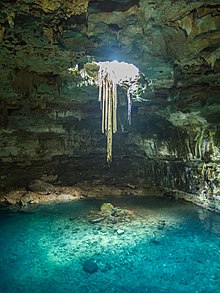

Limestone is partially soluble, especially in acid, and therefore forms many erosional landforms. These include limestone pavements, pot holes, cenotes, caves and gorges. Such erosion landscapes are known equally karsts. Limestone is less resistant to erosion than most igneous rocks, but more resistant than nearly other sedimentary rocks. Information technology is therefore unremarkably associated with hills and downland, and occurs in regions with other sedimentary rocks, typically clays.[84] [85]
Karst regions overlying limestone bedrock tend to have fewer visible to a higher place-ground sources (ponds and streams), equally surface water easily drains downward through joints in the limestone. While draining, water and organic acid from the soil slowly (over thousands or millions of years) enlarges these cracks, dissolving the calcium carbonate and conveying it abroad in solution. Most cavern systems are through limestone bedrock. Cooling groundwater or mixing of different groundwaters will likewise create conditions suitable for cave formation.[84]
Coastal limestones are often eroded past organisms which bore into the rock past various ways. This process is known equally bioerosion. It is about mutual in the tropics, and it is known throughout the fossil record.[86]
Bands of limestone emerge from the Globe's surface in often spectacular rocky outcrops and islands. Examples include the Rock of Gibraltar,[87] the Burren in County Clare, Ireland;[88] Malham Cove in North Yorkshire and the Isle of Wight,[89] England; the Peachy Orme in Wales;[xc] on Fårö nearly the Swedish isle of Gotland,[91] the Niagara Escarpment in Canada/United States;[92] Notch Peak in Utah;[93] the Ha Long Bay National Park in Vietnam;[94] and the hills around the Lijiang River and Guilin city in China.[95]
The Florida Keys, islands off the south declension of Florida, are composed mainly of oolitic limestone (the Lower Keys) and the carbonate skeletons of coral reefs (the Upper Keys), which thrived in the expanse during interglacial periods when sea level was higher than at present.[96]
Unique habitats are plant on alvars, extremely level expanses of limestone with thin soil mantles. The largest such expanse in Europe is the Stora Alvaret on the island of Öland, Sweden.[97] Another area with large quantities of limestone is the isle of Gotland, Sweden.[98] Huge quarries in northwestern Europe, such every bit those of Mountain Saint Peter (Belgium/Netherlands), extend for more than a hundred kilometers.[99]
Uses [edit]
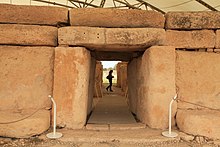

Limestone is a raw material that is used globally in a variety of different ways including construction, agronomics and every bit industrial materials.[101] Limestone is very common in architecture, peculiarly in Europe and North America. Many landmarks across the world, including the Groovy Pyramid and its associated complex in Giza, Egypt, were fabricated of limestone. So many buildings in Kingston, Ontario, Canada were, and go on to be, synthetic from it that information technology is nicknamed the 'Limestone City'.[102] Limestone, metamorphosed by oestrus and force per unit area produces marble, which has been used for many statues, buildings and stone tabletops.[103] On the island of Malta, a variety of limestone called Globigerina limestone was, for a long time, the only building material available, and is all the same very frequently used on all types of buildings and sculptures.[104]
Limestone can exist processed into many diverse forms such every bit brick, cement, powdered/crushed, or as a filler.[105] Limestone is readily available and relatively easy to cutting into blocks or more elaborate carving.[100] Ancient American sculptors valued limestone because it was piece of cake to work and skilful for fine particular. Going back to the Late Preclassic period (by 200–100 BCE), the Maya civilization (Ancient Mexico) created refined sculpture using limestone because of these excellent carving backdrop. The Maya would decorate the ceilings of their sacred buildings (known as lintels) and cover the walls with carved limestone panels. Carved on these sculptures were political and social stories, and this helped communicate messages of the male monarch to his people.[106] Limestone is long-lasting and stands up well to exposure, which explains why many limestone ruins survive. However, it is very heavy (density 2.6[107]), making it impractical for tall buildings, and relatively expensive as a edifice material.
Limestone was most popular in the late 19th and early 20th centuries. Train stations, banks and other structures from that era were normally fabricated of limestone. Information technology is used as a facade on some skyscrapers, but simply in thin plates for covering, rather than solid blocks. In the United States, Indiana, almost notably the Bloomington area, has long been a source of high-quality quarried limestone, chosen Indiana limestone. Many famous buildings in London are built from Portland limestone. Houses built in Odessa in Ukraine in the 19th century were mostly constructed from limestone and the all-encompassing remains of the mines now class the Odessa Catacombs.[108]
Limestone was as well a very popular building block in the Middle Ages in the areas where it occurred, since information technology is hard, durable, and commonly occurs in easily accessible surface exposures. Many medieval churches and castles in Europe are made of limestone. Beer stone was a popular kind of limestone for medieval buildings in southern England.[109]
-
Cutting limestone blocks at a quarry in Gozo, Republic of malta
-
Limestone as building material
-

Limestone is used worldwide as building cloth.
Limestone is the raw textile for production of lime, primarily known for treating soils, purifying water and smelting copper. Lime is an of import ingredient used in chemical industries.[110] Limestone and (to a lesser extent) marble are reactive to acid solutions, making acid rain a significant problem to the preservation of artifacts made from this rock. Many limestone statues and edifice surfaces have suffered severe damage due to acrid pelting.[111] [112] Also limestone gravel has been used to protect lakes vulnerable to acid rain, interim as a pH buffering agent.[113] Acid-based cleaning chemicals can besides etch limestone, which should only be cleaned with a neutral or mild alkali-based cleaner.[114]

A limestone plate with a negative map of Moosburg in Bavaria is prepared for a lithography print.

Plastic bag "made mainly from limestone"
Other uses include:
- Information technology is the raw textile for the manufacture of quicklime (calcium oxide), slaked lime (calcium hydroxide), cement and mortar.[58]
- Pulverized limestone is used every bit a soil conditioner to neutralize acidic soils (agricultural lime).[115]
- Is crushed for employ as aggregate—the solid base for many roads also equally in cobblestone physical.[58]
- Equally a reagent in flue-gas desulfurization, where it reacts with sulfur dioxide for air pollution control.[116]
- In glass making, particularly in the manufacture of soda-lime drinking glass.[117]
- Equally an additive toothpaste, paper, plastics, paint, tiles, and other materials as both white pigment and a cheap filler.[118]
- Equally stone dust, to suppress marsh gas explosions in cloak-and-dagger coal mines.[119]
- Purified, it is added to breadstuff and cereals as a source of calcium.[120]
- As a calcium supplement in livestock feed, such as for poultry (when ground upwards).[121]
- For remineralizing and increasing the alkalinity of purified h2o to foreclose pipe corrosion and to restore essential nutrient levels.[122]
- In blast furnaces, limestone binds with silica and other impurities to remove them from the iron.[123]
- It tin can help in the removal of toxic components created from coal burning plants and layers of polluted molten metals.[124]
Many limestone formations are porous and permeable, which makes them of import petroleum reservoirs.[125] Nigh twenty% of North American hydrocarbon reserves are found in carbonate rock. Carbonate reservoirs are very common in the petroleum-rich Middle East,[58] and carbonate reservoirs hold about a third of all petroleum reserves worldwide.[126] Limestone formations are also mutual sources of metal ores, considering their porosity and permeability, together with their chemic activity, promotes ore deposition in the limestone. The lead-zinc deposits of Missouri and the Northwest Territories are examples of ore deposits hosted in limestone.[58]
Scarcity [edit]
Limestone is a major industrial raw fabric that is in abiding demand. This raw cloth has been essential in the iron and steel industry since the nineteenth century.[127] Companies have never had a shortage of limestone; however, it has become a concern as the demand continues to increase[128] and it remains in high demand today.[129] The major potential threats to supply in the nineteenth century were regional availability and accessibility.[127] The two main accessibility issues were transportation and property rights. Other problems were high capital costs on plants and facilities due to environmental regulations and the requirement of zoning and mining permits.[103] These 2 dominant factors led to the accommodation and selection of other materials that were created and formed to blueprint alternatives for limestone that suited economic demands.[127]
Limestone was classified as a critical raw material, and with the potential risk of shortages, it drove industries to discover new alternative materials and technological systems. This immune limestone to no longer be classified as critical equally replacement substances increased in production; minette ore is a mutual substitute, for instance.[127]
Occupational safety and health [edit]
| NFPA 704 fire diamond | |
|---|---|
| [130] i 0 0 Limestone |
Powdered limestone as a food condiment is generally recognized as prophylactic[131] and limestone is not regarded equally a hazardous fabric. However, limestone dust can be a mild respiratory and skin irritant, and grit that gets into the eyes can crusade corneal abrasions. Because limestone contains minor amounts of silica, inhalation of limestone dust could potentially lead to silicosis or cancer.[130]
United states of america [edit]
The Occupational Safe and Health Administration (OSHA) has set the legal limit (permissible exposure limit) for limestone exposure in the workplace as 15 mg/m3 full exposure and 5 mg/thousandiii respiratory exposure over an eight-60 minutes workday. The National Institute for Occupational Condom and Wellness (NIOSH) has set up a recommended exposure limit (REL) of ten mg/thousand3 total exposure and 5 mg/m3 respiratory exposure over an eight-hr workday.[132]
Graffiti [edit]
Removing graffiti from weathered limestone is difficult because information technology is a porous and permeable material. The surface is frail then usual chafe methods run the chance of astringent surface loss. Because information technology is an acid-sensitive stone some cleaning agents cannot be used due to adverse effects.[133]
Gallery [edit]
-
A stratigraphic section of Ordovician limestone exposed in primal Tennessee, U.Due south. The less-resistant and thinner beds are composed of shale. The vertical lines are drill holes for explosives used during route structure.
-

-

Fossils in limestone from the northern Black Sea region
-
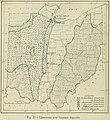
Limestone distribution in Ohio, from "Geography of Ohio," 1923
-

Chalk is a variety of limestone. It is a softer, and more powdery fabric.
Run into besides [edit]
- Coral sand
- In Praise of Limestone – Poem by W. H. Auden
- Kurkar – Regional name for an aeolian quartz calcrete on the Levantine coast
- Limepit – Old method of calcining limestone
- Sandstone – Type of sedimentary rock
References [edit]
- ^ Boggs, Sam (2006). Principles of sedimentology and stratigraphy (4th ed.). Upper Saddle River, N.J.: Pearson Prentice Hall. pp. 177, 181. ISBN0131547283.
- ^ Leong, Goh Cheng (27 October 1995). Certificate Physics And Man Geography; Indian Edition. Oxford University Press. p. 62. ISBN978-0-19-562816-6.
- ^ a b c d east f Boggs 2006, p. 159.
- ^ Blatt, Harvey; Tracy, Robert J. (1996). Petrology : igneous, sedimentary, and metamorphic (second ed.). New York: West.H. Freeman. pp. 295–300. ISBN0716724383.
- ^ Jackson, Julia A., ed. (1997). "Magnesian limestone". Glossary of geology (Fourth ed.). Alexandria, Virginia: American Geological Found. ISBN0922152349.
- ^ Blatt, Harvey; Middleton, Gerard; Murray, Raymond (1980). Origin of sedimentary rocks (2d ed.). Englewood Cliffs, North.J.: Prentice-Hall. pp. 446, 510–531. ISBN0136427103.
- ^ Boggs 2006, p. 182-194.
- ^ Blatt, Middleton & Murray 1980, p. 448-449.
- ^ a b c d Blatt & Tracy 1996, p. 295.
- ^ Boggs 2006, p. 160.
- ^ Blatt, Middleton & Murray 1980, p. 467.
- ^ Blatt & Tracy 1996, pp. 301–302.
- ^ Oates, Tony (17 September 2010). "Lime and Limestone". Kirk-Othmer Encyclopedia of Chemical Technology: 1209130507212019.a01.pub3. doi:10.1002/0471238961.1209130507212019.a01.pub3. ISBN978-0471238966.
- ^ "Compressive strength examination". Encyclopedia Britannica . Retrieved 4 February 2021.
- ^ Blatt & Tracy 1996, pp. 295–296.
- ^ Blatt, Middleton & Murray 1980, p. 452.
- ^ a b Blatt & Tracy 1996, pp. 295–300.
- ^ Blatt, Middleton & Murray 1980, p. 449.
- ^ Boggs 2006, p. 161-164.
- ^ a b Blatt et al. sfn fault: no target: CITEREFBlattTracy1996297-299 (help)
- ^ Boggs 2006, pp. 164–165.
- ^ Adachi, Natsuko; Ezaki, Yoichi; Liu, Jianbo (February 2004). "The fabrics and origins of peloids immediately after the finish-Permian extinction, Guizhou Province, Due south People's republic of china". Sedimentary Geology. 164 (ane–2): 161–178. Bibcode:2004SedG..164..161A. doi:10.1016/j.sedgeo.2003.10.007.
- ^ a b c Blatt & Tracy 1996, p. 298.
- ^ Chafetz, Henry South. (1986). "Marine Peloids: A Production of Bacterially Induced Precipitation of Calcite". SEPM Journal of Sedimentary Inquiry. 56 (6): 812–817. doi:10.1306/212F8A58-2B24-11D7-8648000102C1865D.
- ^ Samankassou, Elias; Tresch, Jonas; Strasser, André (26 November 2005). "Origin of peloids in Early Cretaceous deposits, Dorset, South England" (PDF). Facies. 51 (1–4): 264–274. doi:10.1007/s10347-005-0002-8. S2CID 128851366.
- ^ Blatt & Tracy 1996, p. 299-300, 304.
- ^ Blatt, Middleton & Murray 1980, p. 460.
- ^ a b c Blatt & Tracy 1996, p. 300.
- ^ Boggs 2006, p. 166.
- ^ a b c Trower, Elizabeth J.; Lamb, Michael P.; Fischer, Woodward West. (16 March 2019). "The Origin of Carbonate Mud". Geophysical Research Messages. 46 (5): 2696–2703. Bibcode:2019GeoRL..46.2696T. doi:10.1029/2018GL081620. S2CID 134970335.
- ^ a b Boggs 2006, pp. 166–167.
- ^ Blatt & Tracy 1996, pp. 315–317.
- ^ Fratini, Fabio; Pecchioni, Elena; Cantisani, Emma; Antonelli, Fabrizio; Giamello, Marco; Lezzerini, Marco; Canova, Roberta (December 2015). "Portoro, the black and gold Italian "marble"". Rendiconti Lincei. 26 (4): 415–423. doi:10.1007/s12210-015-0420-seven. S2CID 129625906.
- ^ Blatt & Tracy 1996, pp. 474.
- ^ "Carbonate Nomenclature: SEPM STRATA".
- ^ Folk, R. L. (1974). Petrology of Sedimentary Rocks. Austin, Texas: Hemphill Publishing. ISBN0-914696-14-ix.
- ^ Dunham, R. J. (1962). "Classification of carbonate rocks according to depositional textures". In Ham, Due west. E. (ed.). Classification of Carbonate Rocks. American Association of Petroleum Geologists Memoirs. Vol. 1. pp. 108–121.
- ^ Wright, V.P. (1992). "A revised Classification of Limestones". Sedimentary Geology. 76 (3–4): 177–185. Bibcode:1992SedG...76..177W. doi:x.1016/0037-0738(92)90082-3.
- ^ Blatt, Middleton & Murray 1980, p. 479-480.
- ^ a b Boggs 2006, p. 172.
- ^ Boggs 2006, p. 177.
- ^ Boggs 2006, pp. 174–176.
- ^ Morse, John Due west.; Mackenzie, F.T. (1990). Geochemistry of sedimentary carbonates. Amsterdam: Elsevier. p. 217. ISBN9780080869629.
- ^ Boggs 2006, pp. 176–182.
- ^ Jerry Lucia, F. (September 2017). "Observations on the origin of micrite crystals". Marine and Petroleum Geology. 86: 823–833. doi:10.1016/j.marpetgeo.2017.06.039.
- ^ Blatt, Middleton & Murray 1980, pp. 460–464.
- ^ Boggs 2006, p. 180.
- ^ Boggs 2006, pp. 177, 181.
- ^ Blatt, Middleton & Murray 1980, pp. 497–501.
- ^ Blatt, Middleton & Murray 1980, p. 497-503.
- ^ Blatt & Tracy 1996, p. 312.
- ^ Blatt, Middleton & Murray 1980, pp. 507–509.
- ^ a b Blatt & Tracy 1996, p. 312-316.
- ^ a b Boggs 2006, pp. 186–187.
- ^ a b Machel, Hans 1000. (2004). "Concepts and models of dolomitization: a critical reappraisal". Geological Society, London, Special Publications. 235 (1): vii–63. Bibcode:2004GSLSP.235....7M. doi:10.1144/GSL.SP.2004.235.01.02. S2CID 131159219.
- ^ a b Blatt, Middleton & Murray 1980, pp. 512–528.
- ^ Luczaj, John A. (November 2006). "Bear witness against the Dorag (mixing-zone) model for dolomitization forth the Wisconsin arch ― A case for hydrothermal diagenesis". AAPG Message. ninety (11): 1719–1738. doi:ten.1306/01130605077.
- ^ a b c d e Blatt, Middleton & Murray 1980, p. 445.
- ^ Blatt, Middleton & Murray 1980, p. 448.
- ^ Boggs 2006, p. 159-161.
- ^ Boggs 2006, p. 176-177.
- ^ Blatt, Middleton & Murray 1980, p. 446, 733.
- ^ Blatt, Middleton & Murray 1980, p. 468-470.
- ^ Blatt, Middleton & Murray 1980, p. 446-447.
- ^ Blatt & Tracy 1996, p. 306-307.
- ^ Blatt, Middleton & Murray 1980, p. 474-479.
- ^ Blatt & Tracy 1996, p. 308-309.
- ^ Roeser, Patricia; Franz, Sven O.; Litt, Thomas (i December 2016). "Aragonite and calcite preservation in sediments from Lake Iznik related to lesser lake oxygenation and water column depth". Sedimentology. 63 (7): 2253–2277. doi:10.1111/sed.12306. ISSN 1365-3091. S2CID 133211098.
- ^ Blatt, Middleton & Murray 1980, p. 480-482.
- ^ a b Blatt & Tracy 1996, p. 309-310.
- ^ Trewin, Northward. H.; Davidson, R. G. (1999). "Lake-level changes, sedimentation and faunas in a Center Devonian basin-margin fish bed". Journal of the Geological Gild. 156 (3): 535–548. Bibcode:1999JGSoc.156..535T. doi:10.1144/gsjgs.156.3.0535. S2CID 131241083.
- ^ "Term 'evaporite'". Oilfield Glossary. Archived from the original on 31 January 2012. Retrieved 25 Nov 2011.
- ^ Boggs 2006, p. 662.
- ^ Blatt, Middleton & Murray 1980, pp. 446, 471–474.
- ^ Blatt, Middleton & Murray 1980, pp. 446–471.
- ^ Blatt & Tracy 1996, p. 304.
- ^ Ehrlich, Henry Lutz; Newman, Dianne K. (2009). Geomicrobiology (5th ed.). pp. 181–182. ISBN9780849379079. Archived from the original on ten May 2016.
- ^ Blatt & Tracy 1996, p. 307.
- ^ Pratt, Brian R. (1995). "The origin, biota, and evolution of deep-water mud-mounds". Spec. Publs Int. Ass. Sediment. 23: 49–123. ISBN9781444304121 . Retrieved 4 February 2021.
- ^ a b Blatt & Tracy 1996, pp. 307–308.
- ^ Riding, Robert (July 2002). "Structure and composition of organic reefs and carbonate mud mounds: concepts and categories". World-Science Reviews. 58 (i–2): 163–231. Bibcode:2002ESRv...58..163R. doi:10.1016/S0012-8252(01)00089-7.
- ^ Forest, Rachel (1999). Reef evolution. Oxford: Oxford University Press. ISBN0198577842 . Retrieved 5 February 2021.
- ^ McGhee, George R. (2013). When the invasion of land failed : the legacy of the Devonian extinctions. New York: Columbia University Press. p. 101. ISBN9780231160575.
- ^ a b Thornbury, William D. (1969). Principles of geomorphology (2d ed.). New York: Wiley. pp. 303–344. ISBN0471861979.
- ^ "Karst Landscapes of Illinois: Dissolving Bedrock and Collapsing Soil". Prairie Research Institute. Illinois State Geological Survey. Retrieved 26 December 2020.
- ^ Taylor, P. D.; Wilson, M. A. (2003). "Palaeoecology and evolution of marine hard substrate communities" (PDF). Earth-Science Reviews. 62 (i–2): 1–103. Bibcode:2003ESRv...62....1T. doi:ten.1016/S0012-8252(02)00131-9. Archived from the original (PDF) on 25 March 2009.
- ^ Rodrı́guez-Vidal, J.; Cáceres, Fifty.M.; Finlayson, J.C.; Gracia, F.J.; Martı́nez-Aguirre, A. (October 2004). "Neotectonics and shoreline history of the Rock of Gibraltar, southern Iberia". Fourth Scientific discipline Reviews. Elsevier (2004). 23 (18–19): 2017–2029. Bibcode:2004QSRv...23.2017R. doi:x.1016/j.quascirev.2004.02.008. Retrieved 23 June 2016.
- ^ McNamara, Chiliad.; Hennessy, R. (2010). "The geology of the Burren region, Co. Clare, Republic of ireland" (PDF). Projection NEEDN, The Burren Connect Project. Ennistymon: Clare County Quango. Retrieved three February 2021.
- ^ "Isle of Wight, Minerals" (PDF). Archived from the original (PDF) on ii November 2006. Retrieved 8 October 2006.
- ^ Juerges, A.; Hollis, C. E.; Marshall, J.; Crowley, S. (May 2016). "The command of basin evolution on patterns of sedimentation and diagenesis: an example from the Mississippian Great Orme, North Wales". Journal of the Geological Society. 173 (3): 438–456. Bibcode:2016JGSoc.173..438J. doi:10.1144/jgs2014-149.
- ^ Cruslock, Eva Thou.; Naylor, Larissa A.; Foote, Yolanda Fifty.; Swantesson, January O.H. (January 2010). "Geomorphologic equifinality: A comparison between shore platforms in Höga Kusten and Fårö, Sweden and the Vale of Glamorgan, Southward Wales, UK". Geomorphology. 114 (1–two): 78–88. Bibcode:2010Geomo.114...78C. doi:10.1016/j.geomorph.2009.02.019.
- ^ Luczaj, John A. (2013). "Geology of the Niagara Escarpment in Wisconsin". Geoscience Wisconsin. 22 (1): one–34. Retrieved v Feb 2021.
- ^ Miller, James F. (1969). "Conodont Fauna of the Notch Acme Limestone (Cambro-Ordovician), House Range, Utah". Journal of Paleontology. 43 (ii): 413–439. JSTOR 1302317.
- ^ Tran Duc Thanh; Waltham Tony (1 September 2001). "The outstanding value of the geology of Ha Long Bay". Advances in Natural Sciences. 2 (iii). ISSN 0866-708X.
- ^ Waltham, Tony (2010). Migon, Piotr (ed.). Guangxi Karst: The Fenglin and Fengcong Karst of Guilin and Yangshuo, in Geomorphological Landscapes of the World. Springer. pp. 293–302. ISBN9789048130542.
- ^ Mitchell-Tapping, Hugh J. (Spring 1980). "Depositional History of the Oolite of the Miami Limestone Formation". Florida Scientist. 43 (2): 116–125. JSTOR 24319647.
- ^ Thorsten Jansson, Stora Alvaret, Lenanders Tryckeri, Kalmar, 1999
- ^ Laufeld, S. (1974). Silurian Chitinozoa from Gotland. Fossils and Strata. Universitetsforlaget.
- ^ Pereira, Dolores; Tourneur, Francis; Bernáldez, Lorenzo; Blázquez, Ana García (2014). "Petit Granit: A Belgian limestone used in heritage, structure and sculpture" (PDF). Episodes. 38 (2): 30. Bibcode:2014EGUGA..sixteen...30P. Retrieved 5 Feb 2021.
- ^ a b Cassar, Joann (2010). "The use of limestone in celebrated context". In Smith, Bernard J. (ed.). Limestone in the Congenital Environment: Nowadays-day Challenges for the Preservation of the By. Geographical Society of London. pp. xiii–23. ISBN9781862392946. Archived from the original on 15 February 2017.
- ^ Oates, J. A. (n.d.). Lime and limestone. Retrieved February 23, 2021, from https://books.google.ca/books?id=MVoEMNI5Vb0C&printsec=frontcover&dq=limestone%2Buses&hl=en&sa=Ten&ved=2ahUKEwje2dHc2YDvAhWviK0KHSb7CGcQ6AEwAHoECAQQAg#v=onepage&q=limestone%20uses&f=false
- ^ "Welcome to the Limestone City". Archived from the original on twenty February 2008. Retrieved 13 February 2008.
- ^ a b Corathers, L.A. (15 Feb 2019). "Lime". Metals and minerals: Usa Geological Survey Minerals Yearbook 2014, Volume i. Washington, DC: USGS (published 2018). p. 43.1. ISBN978-one-4113-4253-8.
- ^ Cassar, Joann (2010). "The employ of limestone in a historic context – the experience of Republic of malta". Geological Society, London, Special Publications. 331 (1): xiii–25. Bibcode:2010GSLSP.331...13C. doi:10.1144/SP331.2. S2CID 129082854.
- ^ Oates, J. A. (n.d.). Lime and limestone. Retrieved Feb 23, 2021, from https://books.google.ca/books?id=MVoEMNI5Vb0C&printsec=frontcover&dq=limestone%2Buses&hl=en&sa=X&ved=2ahUKEwje2dHc2YDvAhWviK0KHSb7CGcQ6AEwAHoECAQQAg#v=onepage&q=limestone%20uses&f=false
- ^ Schele, Linda; Miller, Mary Ellen. The Claret of Kings: Dynasty and Ritual in Maya Art. Kimbell Art Museum. p. 41.
- ^ P. V. Sharma (1997), Ecology and Engineering Geophysics, Cambridge University Press, p. 17, doi:ten.1017/CBO9781139171168, ISBN9781139171168
- ^ "Odessa catacombs". Odessa travel guide. Retrieved thirteen June 2020.
- ^ Ashurst, John; Dimes, Francis G. (1998). Conservation of building and decorative rock. Butterworth-Heinemann. p. 117. ISBN978-0-7506-3898-2.
- ^ Elation, J. D., Hayes, T. South., & Orris, G. J. (2012, August). Limestone—A Crucial and Versatile Industrial Mineral Article. Retrieved Feb 23, 2021, from https://pubs.usgs.gov/fs/2008/3089/fs2008-3089.pdf
- ^ Reisener, A.; Stäckle, B.; Snethlage, R. (1995). "ICP on effects on materials". Water, Air, & Soil Pollution. 85 (4): 2701–2706. Bibcode:1995WASP...85.2701R. doi:10.1007/BF01186242. S2CID 94721996.
- ^ "Approaches in modeling the bear upon of air pollution-induced material deposition" (PDF). Archived from the original (PDF) on 16 July 2011. Retrieved 18 Nov 2010.
- ^ Clayton, Janet Fifty.; Dannaway, Eric S.; Menendez, Raymond; Rauch, Henry West.; Renton, John J.; Sherlock, Sean M.; Zurbuch, Peter East. (1998). "Awarding of Limestone to Restore Fish Communities in Acidified Streams". N American Journal of Fisheries Direction. 18 (two): 347–360. doi:10.1577/1548-8675(1998)018<0347:AOLTRF>2.0.CO;2.
- ^ Hatch, Jonathan (18 Apr 2018). "How to clean limestone". How to Make clean Things. Saint Paul Media, Inc. Retrieved 5 February 2021.
- ^ Oates, J. A. H. (eleven July 2008). Lime and Limestone: Chemistry and Technology, Production and Uses. John Wiley & Sons. pp. 111–3. ISBN978-3-527-61201-7.
- ^ Gutiérrez Ortiz, F. J.; Vidal, F.; Ollero, P.; Salvador, L.; Cortés, V.; Giménez, A. (February 2006). "Airplane pilot-Plant Technical Assessment of Wet Flue Gas Desulfurization Using Limestone". Industrial & Applied science Chemistry Inquiry. 45 (four): 1466–1477. doi:10.1021/ie051316o.
- ^ Kogel, Jessica Elzea (2006). Industrial Minerals & Rocks: Commodities, Markets, and Uses. SME. ISBN9780873352338. Archived from the original on sixteen December 2017.
- ^ Huwald, Eberhard (2001). "Calcium carbonate - pigment and filler". Calcium Carbonate: 160–170. doi:x.1007/978-3-0348-8245-3_7. ISBN978-3-0348-9490-six.
- ^ Human being, C.K.; Teacoach, K.A. (2009). "How does limestone rock dust preclude coal grit explosions in coal mines?" (PDF). Mining Technology: 61. Retrieved xxx November 2020.
- ^ "Why Fortified Flour?". Wessex Mill . Retrieved v February 2021.
- ^ "A Guide to Giving Your Layer Hens Plenty Calcium". Poultry I. Archived from the original on iii April 2009.
- ^ "Nutrient minerals in drinking-water and the potential health consequences of consumption of demineralized and remineralized and altered mineral content drinking-water: Consensus of the meeting". World Health Organization report. Archived from the original on 24 December 2007.
- ^ Tylecote, R. F. (1992). A history of metallurgy (2nd ed.). London: Institute of Materials. ISBN978-0901462886.
- ^ Elation, J. D., Hayes, T. S., & Orris, Yard. J. (2012, August). Limestone—A Crucial and Versatile Industrial Mineral Commodity. Retrieved February 23, 2021, from https://pubs.usgs.gov/fs/2008/3089/fs2008-3089.pdf
- ^ Archie, One thousand.Eastward. (1952). "Classification of Carbonate Reservoir Rocks and Petrophysical Considerations". AAPG Bulletin. 36. doi:ten.1306/3D9343F7-16B1-11D7-8645000102C1865D.
- ^ Boggs 2006, p. p=159.
- ^ a b c d Haumann, Due south. (2020). "Critical and scarce: the remarkable career of limestone 1850–1914". European Review of History: Revue européenne d'histoire. 27 (3): 273–293. doi:10.1080/13507486.2020.1737651. S2CID 221052279.
- ^ Sparenberg, O.; Heymann, 1000. (2020). "Introduction: resources challenges and constructions of scarcity in the nineteenth and twentieth centuries". European Review of History: Revue européenne d'histoire. 27 (3): 243–252. doi:10.1080/13507486.2020.1737653. S2CID 221055042.
- ^ ResearchAndMarkets.com (nine June 2020). "Global Limestone Market Analysis and Forecasts 2020-2027 - Steady Growth Projected over the Next Few Years - ResearchAndMarkets.com". Limestone - Global Marketplace Trajectory & Analytics. businesswire.com. Retrieved 24 March 2021.
- ^ a b Lhoist Due north America. "Cloth Safe Data Sheet: Limestone" (PDF) . Retrieved v February 2021.
- ^ "CFR - Code of Federal Regulations Title 21". US Nutrient & Drug Administration. US Department of Health & Human Services. Retrieved 5 Feb 2021.
- ^ "Limestone". NIOSH Pocket Guide to Chemical Hazards. CDC. Archived from the original on 20 Nov 2015. Retrieved 19 Nov 2015.
- ^ Weaver, Martin East. (Oct 1995). "Removing Graffiti from Historic Masonry". National Park Service. Retrieved 5 February 2019.
Farther reading [edit]
| | Wikimedia Commons has media related to Limestone. |
- Boynton, Robert South. (1980). Chemistry and Technology of Lime and Limestone. Wiley. ISBN0471027715.
Source: https://en.wikipedia.org/wiki/Limestone
Posted by: smithwich1999.blogspot.com




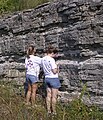
0 Response to "What Type Of Particles/sediment Makeup Limestone? How Is Calcium Carbonate Produced By Coral Reefs?"
Post a Comment